|
 |
|
History Of CSI
Central
Kerala Diocese
|
|
|
|
The CSI Madhya Kerala
Chapter 1
Chapter 2
Chapter 3
Home /
About
Us
Articles
|
|
THE
CSI MADHYA KERALA DIOCESE
by
REV.
C. Y. THOMAS
CHAPTER 2
DIOCESE
OF TRAVANCORE AND COCHIN
Early
in 1876, the Society began negotiations with the Secretary of State for
India so that a new see might be formed under the Jerusalem Bishopric
Act 1 for the Church of England in the Native States of
Travancore and Cochin. And towards the end of the year a public
announcement was made that the Rev. J. M. Speechly, then Principal of
the C. N. I., would be the first Bishop of the New Diocese. It was also
made clear that "the appointment of an experienced European
Missionary as a Bishop was a preparatory step to the ultimate
appointment of native Bishops". 2 Rev. J. M. Speechly
(1879-1888) was consecrated as the first Bishop for the newly
formed Anglican Diocese of Travancore and Cochin, on St. James Day, the
25
July 1879, in St. Paul's Cathedral, London, and he
arrived at Kottayam on January 27, 1880.
The main intention of the Society to form a Diocese
was, "to build up well-trained native congregations under
native pastors... to resign all pastoral work into their hands" and
for the missionary gradually, "to relax his superintendence over
the pastors themselves, till it insensibly ceases." 3 To
this end there began a steady increase in the number of the local
ministers and the condition of the Native Church began to be improved.
From July 18 80, a Diocesan Magazine in English was published known as
'The Diocesan Gazette' and later changed its name as 'The Diocesan
Record'. The editor wrote, "Our readers are lay and clerical,
native and European, learned and liberal Hindus, the Christians of the
S.P.G. (Society for Promoting Gospel), L.M.S. (London Missionary
Society), and C.M.S. Missions. We have subscribers in the three
presidencies." 4 During the episcopate of Bishop
Speechly there were four Mission districts - Kottayam,
Mavelikara, Thiruvalla and Mundakayam, of which Melukavu Mission
was a part. The Mundakayam Mission District was not yet incorporated
with the provincial council.
|
|
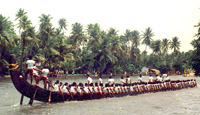
Snake Boat
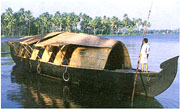
House Boat
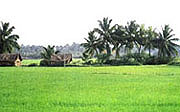
Paddy Farm
|
It was another step forward in the Diocesan life when
in 1885 a Malayalee, the Rev. K. Koshi, was appointed Archdeacon of
Kottayam. The Rev. J. Caley was the Archdeacon of Mavelikara. Rev. K.
Koshi was an eminent scholar, which was proved by the fact that in 1892
he was given the honorary degree of Doctor of Divinity by the Archbishop
of Canterbury for his good work as chief reviser of the Bible in
Malayalam.
In 1888 the Rt. Rev. J. M. Speechly left for England
and was unable to return, and the Rt. Rev. E. N. Hodges (1890-1904), a
C.M.S. Missionary from Ceylon followed him as the Bishop of the Diocese.
He was installed in the Pro-Cathedral, Kottayam. in November 1890.
It was at this time that a reformed section of the Jacobites left
the Orthodox Church and formed the Marthoma Church. The
newly formed church was progressive and fervent in evangelism, and had
worked closely with the Anglican Church over the years.
In 1894 an Industrial School with a boarding house attached, was opened
in Kottayam for Dalit Christians. It was the resort of the Christians
from the backward classes, when their huts or church sheds were burned
down and their crops carried off by angry upper class people. But things
were changed when a government Proclamation in . formed the public that
"all high roads, markets and courts of justice are open to
all". Bishop Hodges issued an order to the effect that all church
buildings in the Diocese were to be opened to Christians from every
community. As time went on, the church developed and expanded. The
Bishop appointed, in place of a missionary, the Rev. Jacob Chandy to be
his chaplain. In 1896 T.K. Benjamin, the first graduate in the Diocese
was ordained.
A Diocesan conference, forerunner of the Diocesan
Council, was inaugurated by Bishop Hodges in 1896 with the immediate
object of discussing plans for Diocesan participation in the Three
Years' Enterprise (T.Y.E.) in connection with the centenary celebrations
of the Church Missionary Society in 1899. The T.Y.E. was taken up very
earnestly all over the Diocese, resulting in a quickening of life and
the raising of funds. Through, T.Y.E. a noble sum of Rs. 11,000
was raised. 5 Families living far from a church were
eager to build their own churches. Subsequently more pastors were
ordained and more pastorates were formed. The number of the baptised
members of the Church had grown from 22, 388 to 3 5, 910 in 1900,
chiefly by the admission of new members from non‑Christians. 'In
almost all the stations the children were taught in Sunday Schools'. 6
ADOOR MISSION
During the episcopate of Bishop Hodges, the first
Missionary enterprise of the Diocese organized as its Home Mission, was
started at Adoor in 1903. A decade of strenuous evangelistic work was
amply rewarded. In 1914 there were 9 stations with 321 Christians. In
the course of thirty years the field widened and the number of stations
increased to 20 with a total membership of 2600. There were two primary
schools and a weaving school started in 1945. Most of the people were
backward in every walk of life. 7
The period covered by Bishop Hodges' episcopate was a time of
consolidation in the Diocese and general development of Church life. The
work of the missionaries became more and more limited to evangelization
and education. The staff of the CNI and the CMS College were
increasingly “Indian-ised”. Education made great strides and as a
result of the work among the women, the women flock of the Diocese
developed considerably. The evangelization among the backward class had
become a mass movement (whole families and groups coming in together)
demanding much attention and posing considerable problems. 8
With better travel facilities more visitors were coming to Travancore
and it was more closely in touch with world affairs and movements in
Christendom.
Bishop Hodges retired in 1905 and was succeeded by
Bishop Charles Hope Gill (1905-1925), who was consecrated in
Westminster Abbey and arrived in Kottayam. in 1906. He had served as a
CMS Missionary in North India for eighteen years. During this time the
Travancore and Cochin Diocese had just celebrated its Silver Jubilee.
Bishop Gill was a great pastoral Bishop, a true
shepherd of his flock. He traveled far and wide throughout his Diocese
and paid special attention to the least developed areas of the church.
He visited all the centers where there were backward class Christians,
taking services in their humble
prayer sheds. He urged them to have a better position
for which lie helped them and uplift them. Long afterwards the Bishop
said, "Our aim in my time was the unification of the various
elements in our church in the one Body to the glory of God, whose grace
could alone make it possible" 9 It
was during his episcopate that teachers and catechists from the
back-ward class community were first admitted to the Cambridge
Nicholson and Buchanan Institutions
|

Elephants
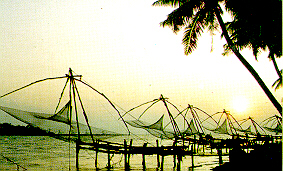
Chinese net - Cochin
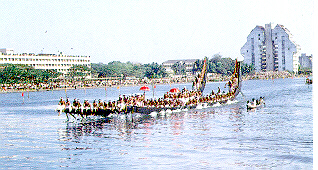
Boat Race

CoirCoir |
|
MOTHERS
UNION
One of the
main features of this period was the development of work among the
women. Consequently Mrs. Gill founded the Mothers' Union in the Diocese
in 1908 and in 1913 was able to get a Mothers' Union Secretary, Miss.
Lilian Davis from England as a full-time worker.
10
Unfortunately, at this time great difficulties
occurred in the church. There were several Christian sects with strange
doctrines. They attracted many, especially of the Dalit Christians, away
from the church.
False teachers also arose, notably a man called
PoyikayiI Yohannan, who misled several people from the church. 11
At the Diocesan Conference, which was held in 1909, the important
subject of the establishment of a Synod for the Diocese was considered.
The Bishop pointed out that the formation of a Synod would be the
natural outcome of the work of the CMS in Travancore. The main object of
its mission was the establishment of native churches
with a view to their ultimate settlement upon a
self-supporting, self-governing, and self-extending
system. 12 The Bishop emphasized the fact that in a synod,
the church would be given the opportunity of functioning as a corporate
body. It had already been working towards that object through its local
committees, District Councils, Provincial Council and Diocesan Council.
A resolution was passed, "that the conference is of opinion that
the time has come for the formation of a Synod for the Diocese, and that
the Bishop of the Diocese be requested to take initial steps for its
establishment." 13
One of the greatest events to be recorded was the
revision of the Malayalam Bible. The new Bible was printed and was ready
for sale in 19 10. From 1914, Gospel Sunday, and then Gospel Week were
observed at the time of the Onam14 Festival. It has become a practice of
the church, and has continued up to the present time.
In 1914, an Anglican Churchmen's Union was formed in
the Diocese with the aim of strengthening the layman's contribution to
the church. It attracted men in positions of influence and leadership
under the able presidentship of Justice P. Cheriyan. From this union
stemmed the Youth work of the Diocese, which began in 1916. 15
|
|

Bekal Fort
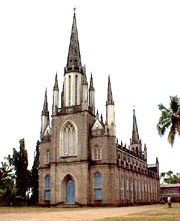
Church

Beach- Cochin
|
In 1915, with a view to forming a Church Synod
for Travancore and Cochin, a Synod formation Committee was appointed,
which drafted
and revised a constitution. There were, however, legal difficulties in
the way of forming such Church Synods. The Bishops of the Indian
Provinces, therefore, at their Synod in 1915, decided upon a system of
Diocesan Councils and Provincial Council for the whole of India. After
this a draft constitution for Provincial Council of the Church in the
Province of India and Ceylon, provisionally accepted by the Episcopal
Synod, and a tentative constitution for Diocesan Council were published.
16
The first World War did not affect South India much
and the work went on steadily. In 1915 there were 36 Indian clergy,
eight men missionaries and two chaplains, seven lady missionaries and
church members numbered 53,655. 17
THE
CENTENARY CELEBRATIONS
The
centenary of the founding of the Mission was celebrated in 1916. There
were local celebrations in various parts of the Diocese, which
culminated in the central celebrations at Kottayam. The
Pro-Cathedral was full to over - flowing for the main
thanksgiving service, and there was as recorded, at the time, 'an
enormous gathering' for the public meeting held in the place where the
Centenary Memorial Building was to be erected.18 .
Educational institutions were going from strength to
strength. The Director of Public Instruction of Travancore State wrote
in 1917: "What struck me most about the Kottayam College was what I
should describe as the collegiate atmosphere. I have never felt this
anywhere in South India as I have felt it here". 19
The Diocesan Record for 1919 notes that the Christian
Institute, Alappuzha was opened and which was the only Reading Room with
a care for souls.
Mention of Union negotiations that finally resulted
in the formation of the Church of South India, began to be mentioned
from time to time in the Diocesan Magazine of that day. Bishop Azariah
of Dornakal, was the inspired leader behind this union movements.
Meanwhile, the idea of a Union College was conceived by a group of men
of spiritual power and vision, who were seeking a way to overcome the
divisions between the churches in Travancore and Cochin. The idea was to
work and worship together and so grow into oneness. Thus the Union
College, Aluva, run by a team of Jacobites, Marthornites and Anglicans
(now C.S.I.) came into being as a resident second grade college and was
opened in 1921.
DIOCESANISATION
The
Diocesanisation which began in 1879 fulfilled in 1920, when Bishop Gill
constituted, "Travancore and Cochin Diocesan Council" to
assist in the management of the temporal affairs and financial business
of the Church. Its first business was to relate all existing
organizations to the Diocesan Council, and a standing Committee was
appointed.
KARAPPURAM
MISSION
In
1921 an extensive effort to reach a thousand Ezhava Families living in
the costal areas was set on foot by an independent committee, in
relation with the Church. With Miss. Isabel Baker's (C.M.S. Missionary)
generous contribution, a school, hospital and a coir factory were
established under the title 'Karappuram. Mission' in the Shertellai
area. Later this was a famine center and a fertile ground for communism.
In 1953 the Diocese undertook full responsibility of the mission but it
continued to fail.
BETHEL
ASHRAM
In
1922, Miss. Neve, a C.M.S. Missionary, felt the need to serve the women
of the Diocese in a wider sphere than in the Training School (B.I.
Pallom) 20 where she was working. Miss. Rachel Joseph, a high
school teacher, joined her in the new venture. They rented a house in
Alappuzha and undertook various activities among the women there. The
name 'Bethel' was adopted, and their work soon attracted women
students from all parts of the Diocese.
Bethel
moved to permanent quarters at Warikkad, Tiruvalla, in 1926. In the same
year, the community school for backward class children was started.
There were a home for motherless babies, a creehe, a dispensary,
industrial section and all the other activities of the community. When
the C.M.S. headquarters secretaries visited Bethel in 1934, they were
impressed by its distinctive Indian character and the emphasis placed by
the Ashram upon, "meditation and devotion. 21 Branches
of Bethel have subsequently been opened at Trichur, Kallada, Parkal and
Melukavu. 'Bethel Day' has throughout been a very popular annual feature
drawing a large crowd year by year.
In
1922, the Rev. T. K. Benjamin, was appointed Archdeacon of Kottayam. and
Bishop's Commissary. It was said at that time, "This is essentially
a step in the right direction and cannot fail to be of great benefit.22
PARKAL
MISSION
Inspired
by the example of Missionary Societies, the Diocese of Travancore and
Cochin started organized missionary work in and outside the Diocese. The
first native missionaries 23 were sent out in 1924, and the
field was Parkal Taluq, Hyderabad in the Dornakal Diocese 24
(Now C.S.I. Karimnagar Diocese).
Progress
was rather slow at first, but after about a decade the work gathered
momentum. The backward Mala and Madiga castes first came under the
influence of the Gospel, but later higher castes were also attracted.
Today there are 10,000 baptized Christians, 100 Christian Villages, 50
worshipping centres, 19 Churches, 28 mission house, 2 orphanages, 2
child care centers, 6 schools, 2 hostels, 3 hospitals, 4 Ashram. Centres,
one technical school and one nursery school. 25
Bishop
Gill retired after a fruitful ministry in 1924. It has been said of him;
"He was the Apostle of the out-castes who championed their cause in
the church, school and state. His blood boiled over in indignation at
the social injustice shown to the depressed classes. He entered into the
work of uplifting Harijans by granting them admission to all Mission
Institutions, establishing Boarding, Schools for them and
abolishing separate seats for them in churches. Vigorous opposition
could not divert him from the right path." 26
Bishop Gilt has also been called the Master Builder of the
Church who established and nourished his congregations with paternal
care and affection.
The
fourth Bishop of the Diocese, the Rt. Rev. E.A.L. Moore, (1925-1937) was
a missionary in Madras. He was consecrated by the Archbishop of
Canterbury and was welcomed to Kottayam with much enthusiasm. Bishop
Moore was a bachelor of rather austere and ascetic habits, and far from
taking a salary, put back his allowances into a diocesan fund.
Diocesanisation progressed rapidly and a well -drawn up Constitution was
passed in December 1926 and came into force on 1st January 1928.
MEDICAL
MISSION
It
was at this time that the medical work was begun in a systematic way.
Bishop Moore started clinics in country boats called 'Floating
Dispensaries' to take medical aid to out of the way places in water
‑ logged areas, each in charge of a doctor. In one month alone we
read that 2,000 patients were treated from one of these mobile
dispensaries. They ran for about 20 years and thereafter discontinued.
By that time small mission hospitals were growing up in different parts
of the Diocese.
The
Community School, Ranni, was started in 1928 to help in the development
of the backward Christian boys of the Diocese. It was a middle school
with a vocational basis, in the morning going for study and in the
afternoon for industrial work. Bishop Moore had keen interest in the
growth and development of out-stations. In order to impart
knowledge and to inspire the Diocesan Evangelistic work, missionary
festivals were organized at various centers. This great gathering became
a strong impetus to giving, praying and working for the spread of the
Gospel. Rev. C. K. Jacob was the chief adviser to the Bishop in this
matter. He was created Archdeacon of Mavelikara in 1932. The Bishop
accepted only genuine believers into the Christian faith, not those who
came, as the Ezhavas at that time, on the wave of a desire for speedy
social improvement. Even Mahatma Gandhi appreciated his attitude when he
came to Travancore at the time of Temple Entry Movement. In 1936, the
famous 'Temple Entry Proclamation' was issued. 27
Following this proclamation several private temples in Travancore
were opened to the lower castes and outcastes of Hinduism.
Significantly, this proclamation made a sudden stop to the discussions
about mass movements 28.
It
was in Bishop Moore's time that the first two men from the backward
Christian community, P. J. Isaac and C.I. Mathai, were ordained as
pastors. By this time the Diocese became fully organized with its
Diocesan Council and standing Committee with the several Boards.
The Missionary Conference was abolished and the several
congregations in the Missionary Districts were brought under the
District Councils. The previously existing four District Councils were
sub‑divided into nine, each with its own separate chairman 29.
The retirement of Bishop Moore came, in the words of the Bishop of
Madras, "after a long service in Madras, Tinnevelly and Travancore.
He was a very fine administrator and a scholar but he was always anxious
to keep in the background and avoid any display of his gifts".30
The
Rev. B.C. Corfield, (1938-1944) a C.M.S. Missionary in North India
succeeded Bishop Moore. He was consecrated as Bishop in St. George
Cathedral, Madras on 18th October 1938. With simplicity and sincerity
and with a particular love for the underprivileged, he began his work.
Bishop Corfield's time was a difficult one. His period roughly covered
the years of the Second World War. Within the country, nationalist
feelings were mounting. There was unrest among the backward Christians
within the Diocese and they were more politically conscious. They began
movement for a 'Separate Administration' fearing the days when a more
democratic regime would mean that they were overshadowed in the Church
by their more advanced Syrian brethren. 31
In 1938, a deaf school was started at Pallom and in 1941 it was moved to
a rented house in Tiruvalla. In 1951, a section of the Tholassery
Mission Compound was given for the school and good buildings were
constructed. In 1940 the Kerala Christian Council was formed consisting
of Marthoma, Anglican and South India United Church as its members.
The Sisterhood connected with Bethel and fore-runner of the Women's
Order of the C.S.I., was formed. In 1944 a large group of women of the
Church was admitted by Bishop Corfield as Associates of the Ashram
Fellowship. There were about 500 members at the time of its inception.
FORWARD MOVEMENT
In 1943, a Forward Movement 'for the spiritual,
evangelistic, social and economic progress of the church in this
Diocese' was inaugurated. Special literature was published. Systematic
giving was urged on church members and there was a consider‑able
increase in the diocesan income from pastorates.
In the same
year 1943, the Kerala United Theological Seminary was started at
Trivandrum. The Anglican
Diocese of Travancore and Cochin had taken the lead in suggesting the
possibility of a union theological college of C.M.S., L.M.S. and Basel
Mission. L.M.S. generously allowed the use of their land and existing
buildings.
INDIGENOUS LEADERSHIP
In 1944 Bishop Corfield, quite unexpectedly, resigned
as the fifth Bishop of the Diocese of Travancore and Cochin 32.
Archdeacon C. K. Jacob was selected to the Bishopric, the first
non-missionary Bishop, and he was consecrated in 1945. Bishop Jacob was
well known for his fervent life of prayer and his knowledge of the
Bible. Besides, he had an intimate knowledge of the Diocese in all its
parts and majority of the Church Workers were his students. His first
Diocesan Council was memorable in that it was conducted for the first
time entirely in Malayalam as well as the first under an Indian Bishop. 33
Every year
Bishop arranged a special mission to the diocese with a missioner from
outside. Mr. Jardine, one missioner wrote about the lay leadership as he
had observed it. "At every center I have observed that this church
is rich in enthusiastic laymen. Retired officials, businessmen, teachers
- all seen to give their time and energy. Quite a number of Young men -
students, ex-soldiers, teachers and workers in firms have told me about
their plans and desire to serve Christ" 34
India
became independent on August 15, 1947, and one month later, the
formation of the Church of South India took place, its inauguration on
27th September 1947 was a historic event - an Indian Church in an
Indian - ruled country.
History
of Madhya (Central) Kerala Diocese.... by
Rev. C.Y. Thomas Contd......
Chapter
1 Chapter 2 Chapter
3
|
Bibliography
Chapter
2
|
|
|
|
|
1
.This was the Act of Parliament passed in 1845 to enable the
consecration of Anglican Bishops for places beyond the King's dominions.
2.
150 years of Service, CMS, p. 30.
3.
The Church Missionary Society, A Manual Outlining its History
Organization and Commitments, London
4.
Eira Dalton. Fellow Workers with God. p.33
5.
W.S. Hunt, The anglican Church in Travancore and Cochin. Vol. II
p.219
6.
Eira Dalton, 'Fellow Workers with God', p. 41.
7.
150 years of Service, CMS p. 25.
8.
Eira Dalton, Fellow Workers with God, p. 42.
9.
lbid, p.42
10.
150 years of service, CMS - p. 24.
11.
W.S. Hunt, The anglican Church in Travancore and Cochin. Vol. II p.235
12.
ibd p.245.
13.
ibd, p. 245
14.
Onam is a national festival of Kerala.
15.
Eira Dalton. 'Fellow workers with God'. p 43
16.
W.S. Hunt, , 'The Anglican
Church in Travancore and Cochin'’ p. 245
17.
Eira Dalton, 'Fellow workers with God', p. 44.
|
|
18.
Anderson Memorial flail. Which is the main building of the Diocesan
Office today.
19.
Eira Dalton, 'Fellow workers with God', p.48.
20.
Buchanan Institution was the first training school for women teachers in
the state.
21.
150 years of service, CMS, ‑ p.24.
22.
Eira Dalton 'Fellow workers with God', p.52
23.
Mr. A. J. Thomas and Mr. K. E. Eapen, ordained in 1934. Mr. A. J. Thomas
soon had to return and his place was filled by Mr. TN. Thomas, ordained
in 1937.
24.
150 years of service CMS p.25
25.
Parkal Mission Paper, 1997, p.2
26.
Eira Dalton, ‘Fellow workers with God’ p.53
27.
J. W. Gladstone, 'Protestant Christianity and people's Movements in
Kerala', p. 410,
28.
Ibid, p. 411.
29.
Report of the Diocese of Travancore and Cochin for 1935 - 1937,
p~5.
30.
Ibid. p.6.
31.
Eira Dalton, ‘Fellow workers with God’ p.57
32.
Eira Dalton, ‘Who Thee by Faith, p. 41
33.
Ibid, p.50
34.
Ibid, p.52
|










